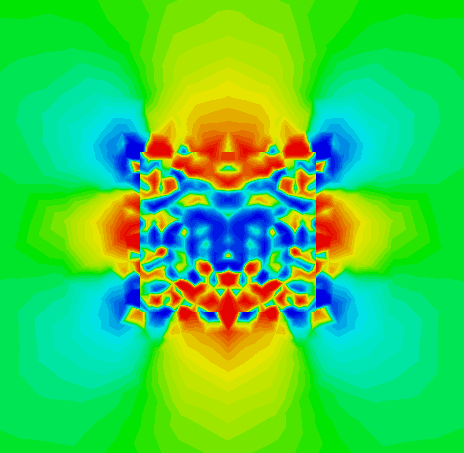High-index dielectric nanoparticles support optically induced electric and magnetic resonances in the visible and near-infrared spectral ranges. These strong tunable resonances and negligible optical losses in silicon in these spectral ranges result in enhanced, ultradirectional scattering of light from silicon nanoparticles. In a homogeneous environment, the unusual radiation patterns of nanoparticles originate from scattering cancellation in either a forward or backward direction. It enables to design functional metasurfaces and optically thin elements.
Lattice Kerker effect
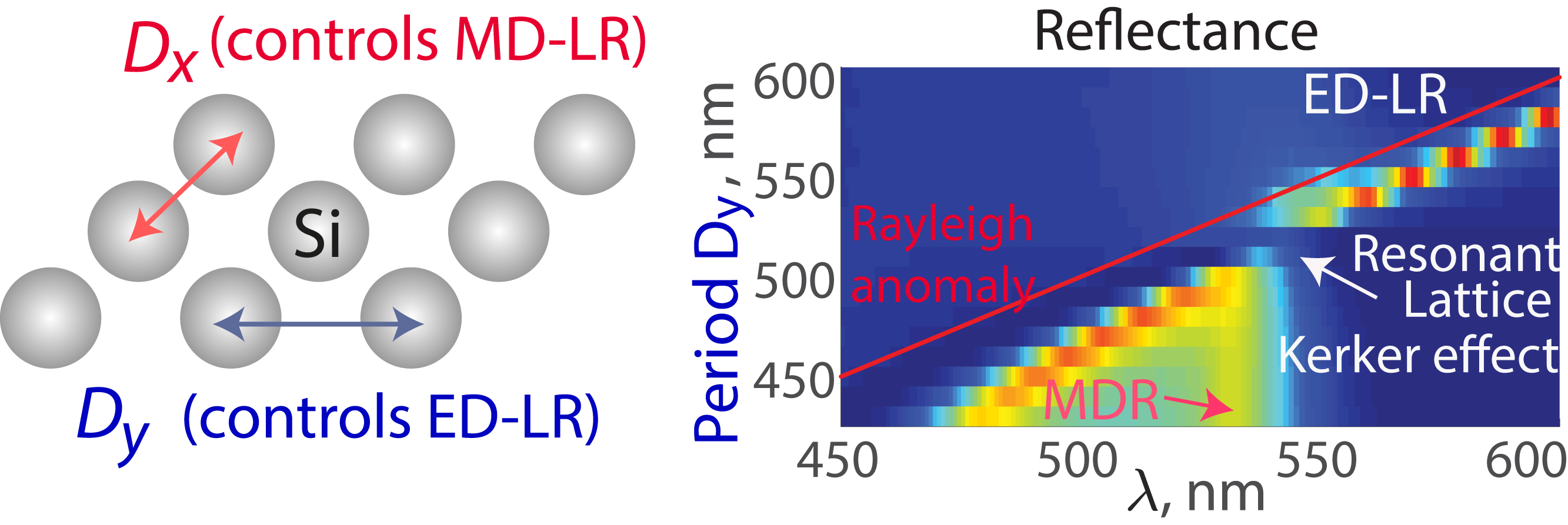 We study two-dimensional periodic arrays of silicon and core-shell nanoparticles that support lattice resonances near the Rayleigh anomaly due to the electric dipole (ED) and magnetic dipole (MD) coupling between the nanoparticles. Dipole coupling in one- and two-dimensional nanoparticle arrays can produce collective lattice resonances, and the wavelengths are determined by the array periods. We show for the first time that it is possible to achieve a full overlap between the ED-lattice resonance and MD resonances of nanoparticles by choosing of lattice periods independently in each mutual-perpendicular direction and to realize the resonant lattice Kerker effect, that is resonant suppression of the light backward scattering and reflection. The strong suppression of light reflectance of the structure is appeared due to destructive interference between electromagnetic waves scattered by ED and MD moments of every nanoparticle in the backward direction with respect to the incident light wave.
We study two-dimensional periodic arrays of silicon and core-shell nanoparticles that support lattice resonances near the Rayleigh anomaly due to the electric dipole (ED) and magnetic dipole (MD) coupling between the nanoparticles. Dipole coupling in one- and two-dimensional nanoparticle arrays can produce collective lattice resonances, and the wavelengths are determined by the array periods. We show for the first time that it is possible to achieve a full overlap between the ED-lattice resonance and MD resonances of nanoparticles by choosing of lattice periods independently in each mutual-perpendicular direction and to realize the resonant lattice Kerker effect, that is resonant suppression of the light backward scattering and reflection. The strong suppression of light reflectance of the structure is appeared due to destructive interference between electromagnetic waves scattered by ED and MD moments of every nanoparticle in the backward direction with respect to the incident light wave.
Publication: V.E. Babicheva and A.B. Evlyukhin, “Resonant Lattice Kerker Effect in Metasurfaces with Electric and Magnetic Optical Responses,” Laser & Photonics Reviews 11, 1700132 (2017). arXiv link
Lattice multipole resonances of plasmonic nanoparticle arrays
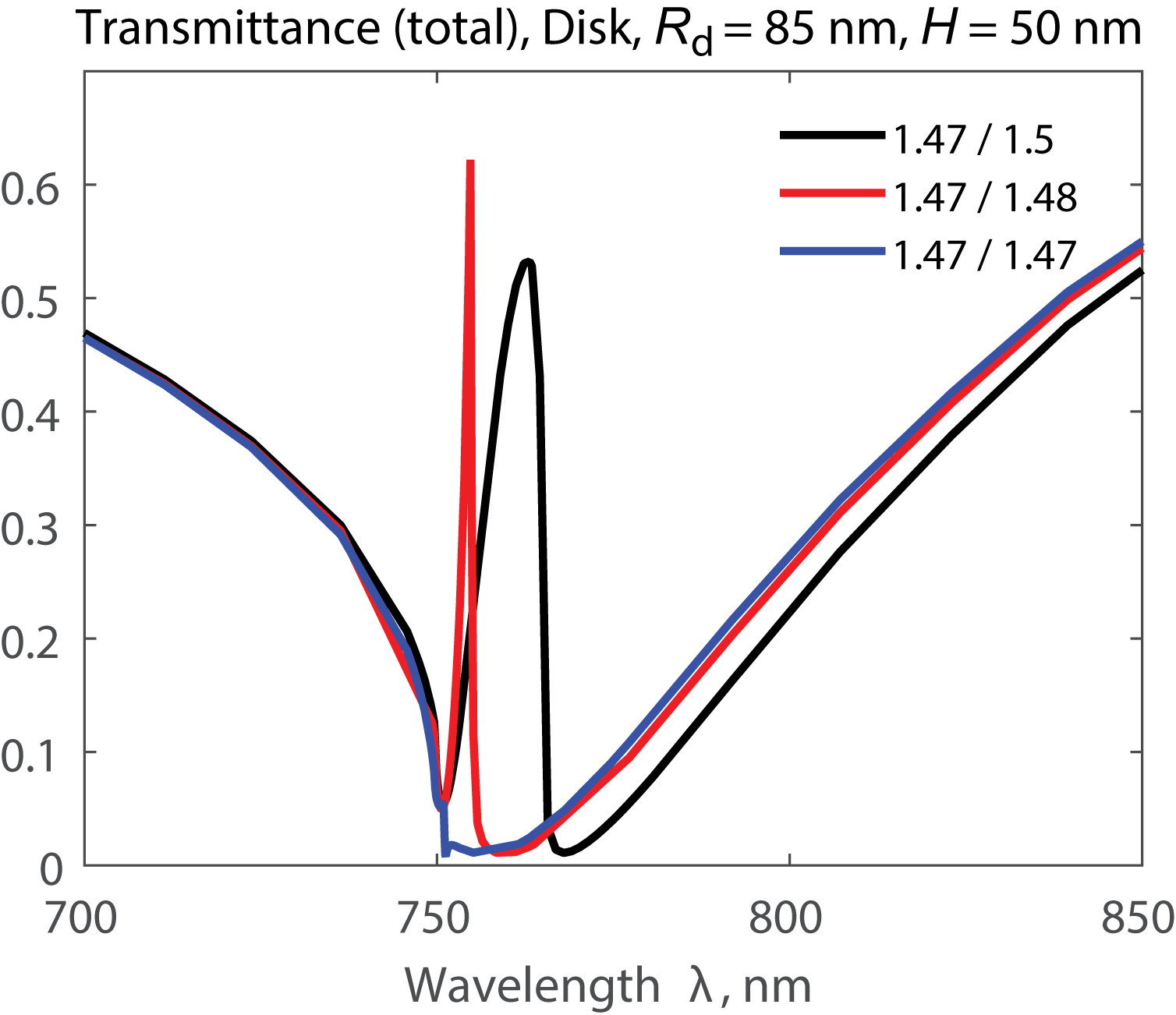 Dipole coupling in periodic nanoparticle arrays can cause narrow lattice resonances in the case when electric dipole moments of the nanoparticles are oriented perpendicular to the direction of periodicity, i.e. transverse-electric polarization [“Collective resonances in gold nanoparticle arrays” B. Auguié, W.L. Barnes, Phys. Rev. Lett. 10, 143902, 2008]. Driven by experimental observation of lattice resonances in the transverse-magnetic polarization [“Diffraction-induced subradiant transverse-magnetic lattice plasmon modes in metal nanoparticle arrays” A.G. Nikitin, Appl. Phys. Lett. 104, 061107, 2014], we systematically study these resonances in plasmonic nanoparticle arrays analyzing contributions of the electric dipole and quadrupole moments by changing particle size and shape. We show that the effect cannot be described using only dipole approximations and taking into account dipole-quadrupole coupling is necessary to observe pronounced resonant features. We also show that for practically important case – a small mismatch between indices of substrate and superstrate – lattice resonances are more pronounced and may result in a band of transparency.
Dipole coupling in periodic nanoparticle arrays can cause narrow lattice resonances in the case when electric dipole moments of the nanoparticles are oriented perpendicular to the direction of periodicity, i.e. transverse-electric polarization [“Collective resonances in gold nanoparticle arrays” B. Auguié, W.L. Barnes, Phys. Rev. Lett. 10, 143902, 2008]. Driven by experimental observation of lattice resonances in the transverse-magnetic polarization [“Diffraction-induced subradiant transverse-magnetic lattice plasmon modes in metal nanoparticle arrays” A.G. Nikitin, Appl. Phys. Lett. 104, 061107, 2014], we systematically study these resonances in plasmonic nanoparticle arrays analyzing contributions of the electric dipole and quadrupole moments by changing particle size and shape. We show that the effect cannot be described using only dipole approximations and taking into account dipole-quadrupole coupling is necessary to observe pronounced resonant features. We also show that for practically important case – a small mismatch between indices of substrate and superstrate – lattice resonances are more pronounced and may result in a band of transparency.
Publication: V.E. Babicheva and A.B. Evlyukhin, “Metasurfaces with electric quadrupole and magnetic dipole resonant coupling,” ACS Photonics 5, 2022 (2018). arXiv link
Antireflective all-dielectric metasurfaces for high-index materials
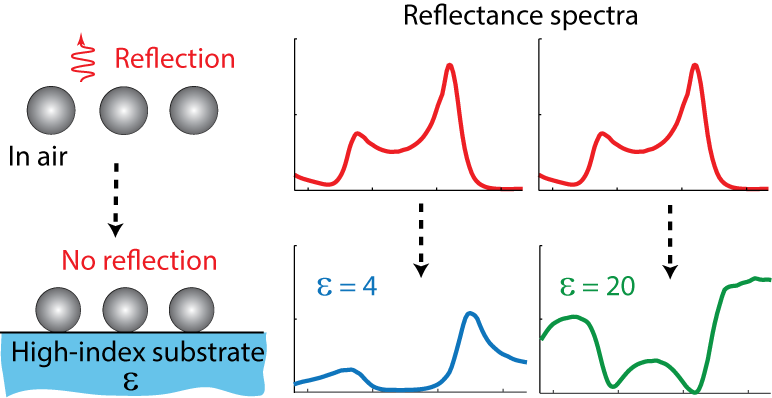 We systematically study the role of substrate in antireflective properties of metasurfaces based on a silicon nanoparticle array and explain how zero backscattering from a highly reflective substrate can be achieved. We propose a semi-analytical model that separately accounts for contributions from the nanoparticle array and the bare substrate, and we show good agreement with whole-structure numerical simulations. The proposed model confirms that all-dielectric metasurfaces can be treated as uncoupled from the substrate, thus, allowing to combine them with other optical elements and preserving their optical properties. This is not the case for plasmonic metasurfaces where the interaction with the substrate is very strong.
We systematically study the role of substrate in antireflective properties of metasurfaces based on a silicon nanoparticle array and explain how zero backscattering from a highly reflective substrate can be achieved. We propose a semi-analytical model that separately accounts for contributions from the nanoparticle array and the bare substrate, and we show good agreement with whole-structure numerical simulations. The proposed model confirms that all-dielectric metasurfaces can be treated as uncoupled from the substrate, thus, allowing to combine them with other optical elements and preserving their optical properties. This is not the case for plasmonic metasurfaces where the interaction with the substrate is very strong.
We apply our model to show that by placing an all-dielectric metasurface on top of a high-index substrate one can achieve reflection suppression at the wavelength between electric and magnetic dipole resonances induced in silicon nanoparticles of the metasurface. The proper phase of the wave scattered by the dipoles provides its destructive interference with the wave reflected from the substrate, which results in reflection suppression. In contrast to the homogeneous environment, where zero backscattering, or Kerker effect, is observed when electric and magnetic moments are in-phase, the reflection suppression from nanoparticle-coated substrate occurs when the out-of-phase condition is satisfied, i.e. for the wavelength between the resonances of electric and magnetic dipole moments.
We also clarify the misunderstanding about the anti-reflective properties of silicon nanoparticles that are often erroneously ascribed to absorption at the resonances rather than by interference effects. We show that reflectance dip and nanoparticle mode resonances may not coincide spectrally, and destructive interference of reflected waves can occur right between nanoparticle mode resonances or other wavelengths depending on array parameters.
Publication: V. Babicheva, M. Petrov, K. Baryshnikova, P. Belov, “Reflection compensation mediated by electric and magnetic resonances of all-dielectric metasurfaces [Invited],” Journal of the Optical Society of America B (JOSA B) 34, D18-D28 (2017).
Plasmonic and silicon nanoparticle antireflective coatings
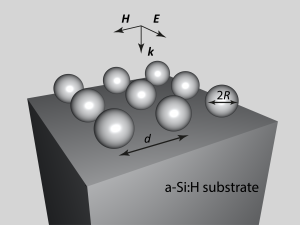
Over the last decade, plasmonic antireflecting nanostructures have been extensively studied to be utilized in various optical and optoelectronic systems such as lenses, solar cells, photodetectors, and others. The growing interest in all-dielectric photonics as an alternative optical technology along with plasmonics motivates us to compare antireflective properties of plasmonic and all-dielectric nanoparticle coatings based on silver and crystalline silicon respectively. Our simulation results for spherical nanoparticles array on top of amorphous silicon show that both silicon and silver coatings demonstrate strong antireflective properties in the visible spectral range. For the first time, we show that zero reflectance from the structure with silicon coatings originates from the destructive interference of electric- and magnetic-dipole responses of nanoparticle array with the wave reflected from the substrate, and we refer to this reflection suppression as substrate-
mediated Kerker effect. We theoretically compare the silicon and silver coating effectiveness for thin-film photovoltaic applications. Silver nanoparticles can be more efficient, enabling up to a 30% increase in the overall absorbance in the semiconductor layer. Nevertheless, silicon coatings allow up to 64% absorbance increase in the narrow band spectral range because of the substrate-mediated Kerker effect, and band position can be effectively tuned by varying the sizes of the nanoparticles.
Publication: K. Baryshnikova, M. Petrov, V. Babicheva, P. Belov, “Plasmonic and silicon spherical nanoparticle antireflective coatings” Sci. Rep. 6, 22136, 2016.
